Misconceptions about dinosaurs are frequently fuelled by their inaccurate (though entertaining) representations in films.
Not everything you've been led to believe about dinosaurs is true.

Numerous movie misconceptions have helped make Tyrannosaurus famous
Misconceptions about dinosaurs are frequently fuelled by their inaccurate (though entertaining) representations in films.
Not everything you've been led to believe about dinosaurs is true.
The extinct reptiles that dominated our planet over 66 million years ago have long captured our imaginations.
As more is understood about dinosaurs, for the most part, our perceptions of them have changed.But some myths have endured thanks to depictions that made certain dinosaurs household names.
We're looking at you, Velociraptor.
Museum dinosaur experts Dr Susie Maidment and Prof Paul Barrett reveal some of the common mistakes made about the ancient reptiles that once dominated Earth.
If you are familiar with Dilophosaurus, a large, venom-spitting, frill-necked lizard may come to mind - at least that's what Steven Spielberg's 1993 film, Jurassic Park, would have you believe.
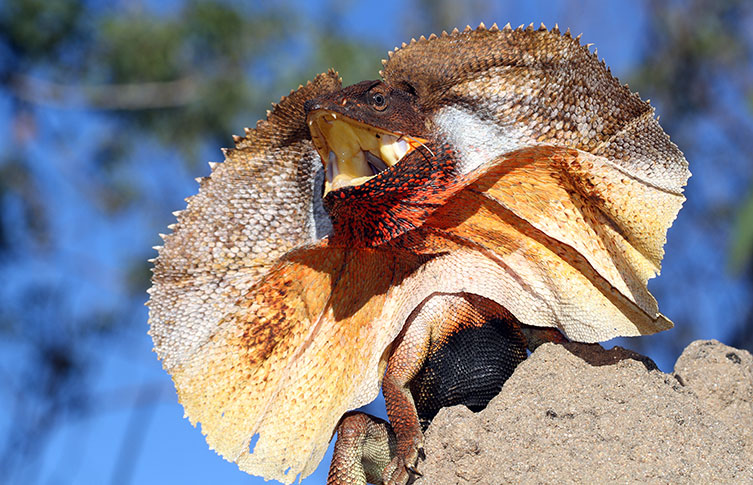
The frill-necked lizard (Chlamydosaurus kingii) appears to have inspired Jurassic Park's Dilophosaurus © Matt from Melbourne, Australiaopens in a new window/ Wikimedia Commons (CC BY 2.0opens in a new window)
Unlike many of the reptiles that feature in the famous park, Dilophosaurus did live during the Jurassic Period. But despite a colourful portrayal, the dinosaur's starring turn was almost certainly all artistic license.
For a start, it probably wasn't venomous. In many living venomous animals, there are distinct pits in the jaw bone that indicate how an animal can deliver a toxic surprise.
Susie says, 'We don't have any evidence that Dilophosaurus or in fact any dinosaurs were able to produce venom. It also had this frill in the film and we don't have any evidence for that either.'
The film's version of the dinosaur was also undersized, which is unusual given movies' go-to approach of making beasts bigger for maximum effect. In reality, an adult Dilophosaurus would have reached around six metres in length - although, you could argue that the dinosaur in the film was a juvenile.
But what the film did get right was the presence of a head crest. This is a known feature of the genus, although it is almost impossible to define its purpose.
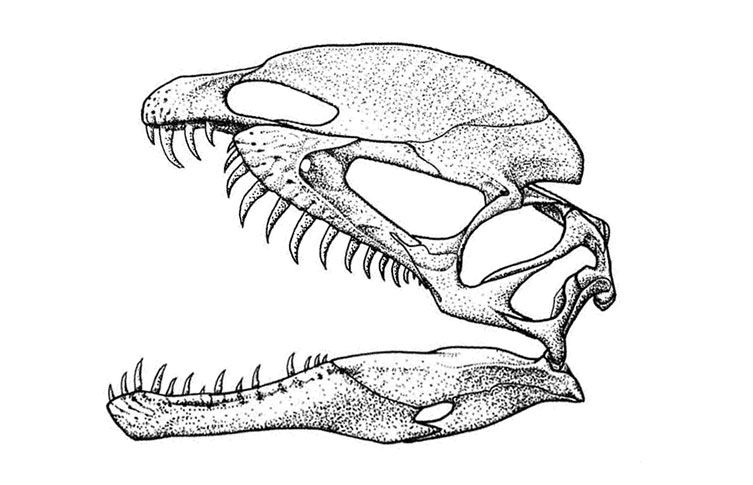
Dilophosaurus had a bony crest on its head, although it isn't known what it was used for © Jaime A Headdenopens in a new window/ Wikimedia Commons (CC BY 3.0opens in a new window). Image cropped.
'It was possibly for attracting a mate,' Susie says. 'If we had lots of specimens then we could potentially look at if the crest was a sexual difference - did the males have crests and the females didn't, for example.
'But Dilophosaurus is a very old dinosaur from about 190 million years ago, and the rocks that it comes from are not prolific at producing fossils - so I expect that we don't have many of them.'
This mistake may be almost 25 years old, but large, featherless Velociraptors remain firmly lodged in many minds.
Velociraptor would actually have been around the size of a turkey - and the cinematic star was actually more like the related theropod Deinonychus.

The Velociraptors of Jurassic Park were closer in size to Deinonychus. Models of these larger dinosaurs can be seen in the Museum's Dinosaurs gallery.
Susie points out that size wasn't the only thing they got wrong:
'The major thing that's wrong these days is that they were naked. Back in 1993 that's how we thought Velociraptor and Deinonychus would have looked. But starting in the mid-1990s there has been a vast number of discoveries of feathered dinosaurs.
'It's absolutely certain that they would have been covered in feathers and they may well have had long, display-type feathers on their forearms.

Scientists used to believe that Velociraptor was covered head-to-toe in scales
'The feathers may have evolved for thermoregulation, so to keep them warm, because these animals may have been warm-blooded.'
Find out more facts about Velociraptor.
Peter Jackson's 2005 King Kong remake features a fictional Tyrannosaurus rex descendant called Vastatosaurus rex. The star, a 7.6-metre-tall gorilla, takes down the mighty meat-eater with apparent ease. The reality (that is, if a giant gorilla were to exist) would likely have been very different.
Paul explains, 'Tyrannosaurus's bite force was about three times stronger than that of an African lion - it had the strongest bite of any animal that has been measured. If T. rex had wrapped its jaws around King Kong's arm, he wouldn't have an arm left - it was a bone-crushing bite.'

The large jaws and powerful bite of Tyrannosaurus would have been more than a match for a giant gorilla
Although it is suggested to have experienced 65 million years of isolated evolution on Skull Island, V. rex falls foul of more than one misconception when compared to its ancestors.
Most theropods had three fingers on each hand, but there were several whose arms and hands were significantly reduced. Tyrannosaurus had two fingers per hand, as would its fictitious descendant.
Paul says, 'We don't know why the forelimbs were so reduced in T. rex. It could be that they weren't used much for prey capture and they were vestigial structures that were gradually being lost through evolution.'
Theropods are also often depicted with bunny hands.

Neave Parker is known for a series of dinosaur reconstructions from the 1960s, such as this Tyrannosaurus illustration. They were based on scientific expertise of the time, but are now known to feature many inaccuracies. Discover more Neave Parker dinosaurs.
'A lot of dinosaurs have this problem. You often see them looking like they're pianists. But when you actually look at the hands and how they work, their palms would actually be facing each other.
'They couldn't rotate their hands into that downward pose. No meat-eating dinosaur that we know of could do that - so they could clap, but they weren't pianists.'
In 2001, Jurassic Park viewers watched as Tyrannosaurus took on Spinosaurus and lost.
But these giants actually missed each other by about 25 million years. Where T. rex lived in the Late Cretaceous, it was the only very large carnivore, so it would never have faced a size-matched adversary.
Spinosaurus was the largest meat-eater ever to live. Although it is a challenge to study this dinosaur due to the lack of fossils, scientists believe that it carved a niche for itself by primarily eating fish and spending most of its time in water.
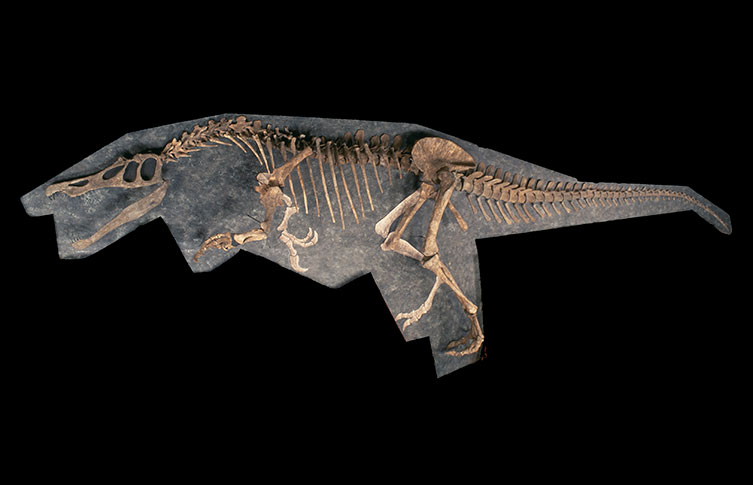
This is a skeleton cast of Baryonyx. This dinosaur was a spinosaurid and related to Spinosaurus, featuring a similar crocodile-like skull.
Susie says, 'In the UK we have Baryonyx, which is a relation of Spinosaurus. If you took the upper jaw off and looked down at the snout, it's kind of rosette-shaped. That is very characteristic of animals that eat fish, both now and in the past.'
Marine-dwelling ancient reptiles (such as ichthyosaurs and pliosaurs) and modern crocodiles also have this distinct jaw shape. Fossilised stomach contents of Baryonyx have also been found that contained fish scales.
'That supports the theory that it was a fish-eating dinosaur. It wasn't just eating fish though - they also found juvenile Iguanodon bones in its stomach.'
Baryonyx and its cousin Spinosaurus may have supplemented their diets with other dinosaurs, but not likely anything nearly as big as Tyrannosaurus.
T. rex wasn't the speed demon it's often made out to be.
'In the first Jurassic Park a Tyrannosaurus chases down an accelerating Jeep. People have looked at running speeds of dinosaurs and the most recent research suggests that T. rex could barely run faster than a human,' says Susie.
T. rex probably had a top speed of only around 16 kilometres per hour, but the dinosaurs it preyed on wouldn't have been moving much faster either.

Slow-moving Triceratops would have been one of the dinosaurs that Tyrannosaurus hunted during the Late Cretaceous
'Triceratops and hadrosaurs probably weren't very quick either. So if Tyrannosaurus was a pursuit predator, everything in the Mesozoic was happening a lot slower than on the Serengeti today.'
Tyrannosaurus was likely a proficient hunter, albeit a slow one. But theories of a strictly scavenging nature persist.
'It's really difficult to tell behaviour from the fossil record. But if you look at modern ecosystems you'll notice that if a lion sees a carcass, it isn't going to pass up the opportunity to eat.
'I think it's a false dichotomy that T. rex was only a hunter and not a scavenger, or only a scavenger and not a hunter. Things that hunt also scavenge. There are very few animals that solely scavenge.'
The relationship between body mass and brain size in living animals is an indicator of intelligence.
Paul says, 'For almost anything we do with dinosaurs we use comparisons with living things as a baseline.
'To get a measure of intelligence of any extinct animal, we use the endocast - that's the shape left behind within the skull that would have been occupied but the brain. You compare the volume of the brain with the mass of the animal.

This is a Stegosaurus reconstruction by artist Neave Parker. We now know that dinosaurs didn't drag their tails along the ground.
'Most dinosaurs fall in line with modern reptiles or birds - their brains are about the expected size for their body size. But there are exceptions such as Troodon, which had a brain much bigger than we'd anticipate for bodies of its size. It looks like this small dinosaur would have been quite smart.'
Stegosaurus was a moderately sized thyreophoran (armoured dinosaur), weighing about 2,000 kilogrammes as an adult. Its brain was particularly small, so when an enlarged section of the spinal column in the sacral (hip) region was noticed, it led to the theory that this had housed a second brain.
'The spinal column tends to be enlarged in lots of dinosaurs, but for some reason it was noticed early on in Stegosaurus, ' says Susie.
'There were theories that its front brain wasn't powerful enough to coordinate its entire body, so if it had a rear brain that might have helped. There may have been a collection of neurons there, but I don't think we'd describe it as a brain.'
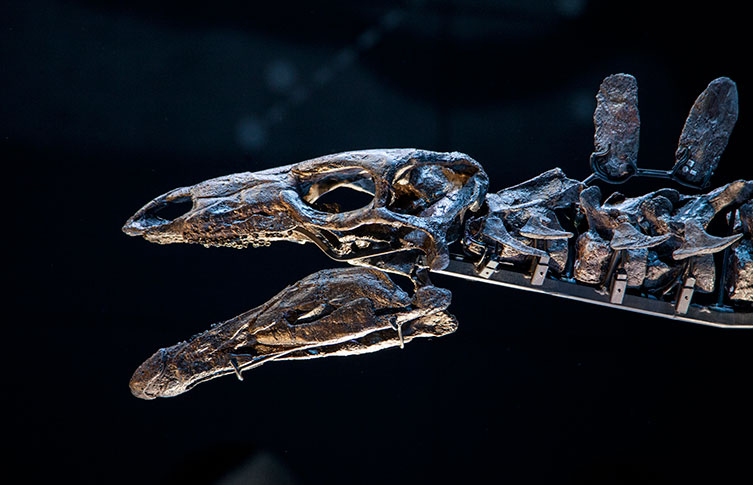
The space in a Stegosaurus's skull is small, but these dinosaurs did not have an extra, posterior brain to back up the small one in their heads.
But a high IQ isn't a vital factor for many animals' ability to survive.
Paul explains, 'Animals don't need to be all that smart. They need to eat, not get eaten or fall under a tree or in a river, and find a mate. So intelligence is rare in the sense of things that have much bigger brains than they need.'
After all, Stegosaurus may have had a small brain, but it still managed to thrive during the Late Jurassic.
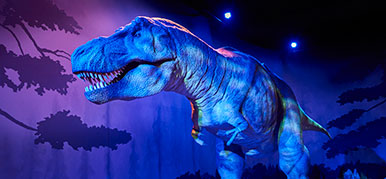
Visit the Dinosaurs gallery and see the ancient animals that once roamed Earth.
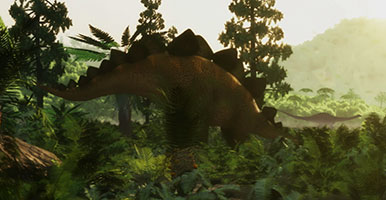
Find out what Museum scientists are revealing about how dinosaurs looked, lived and behaved.
Don't miss a thing
Receive email updates about our news, science, exhibitions, events, products, services and fundraising activities. We may occasionally include third-party content from our corporate partners and other museums. We will not share your personal details with these third parties. You must be over the age of 13. Privacy notice.
Follow us on social media